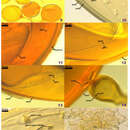en
names in breadcrumbs


The Gigasporaceae are a family of fungi in the order Diversisporales. Species in this family are widespread in distribution, and form arbuscular mycorrhiza in roots.[3]
A species under Gigasporaceae is Gigaspora gigantea. The spores of G. gigantea, found in specific sand dunes, commence in a healthy state of newly formed spores to dead and blackened in seven months through four identifiable steps: they begin as healthy greenish-yellow spores, turn into yellow with brown spots, then reddish-orange-brown, and ultimately dead. A cause of the symptoms of death in spores are soil organisms such as bacteria, protists, and microfauna.[4]
The Gigasporaceae are a family of fungi in the order Diversisporales. Species in this family are widespread in distribution, and form arbuscular mycorrhiza in roots.
A species under Gigasporaceae is Gigaspora gigantea. The spores of G. gigantea, found in specific sand dunes, commence in a healthy state of newly formed spores to dead and blackened in seven months through four identifiable steps: they begin as healthy greenish-yellow spores, turn into yellow with brown spots, then reddish-orange-brown, and ultimately dead. A cause of the symptoms of death in spores are soil organisms such as bacteria, protists, and microfauna.